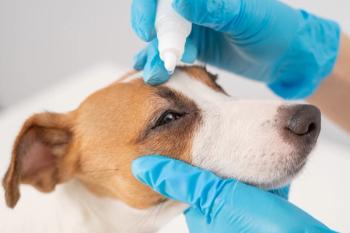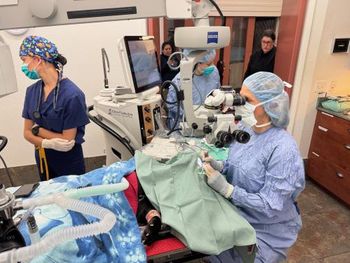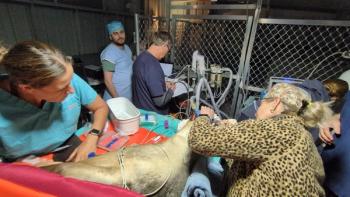
Hope for retinal detachments and other severe retinal diseases (Proceedings)
Retinal reattachment surgery has become increasingly important part of the veterinary ophthalmologists tools in managing patients with rhegmatogenous retinal detachments (RRD).
Retinal Detachments
Retinal reattachment surgery has become increasingly important part of the veterinary ophthalmologists tools in managing patients with rhegmatogenous retinal detachments (RRD). Availability of this service in the United States is increasing. As the level of care rises throughout the veterinary profession, animal owners are no longer content with their pet losing vision to a retinal detachment, whether from trauma, as result of cataract surgery or lens luxation or because of inherited conditions such as vitreous degeneration.
Retinal detachment (RD) is the separation of the neurosensory retina (rods, cones and inner layers) from the retinal pigmented epithelium (RPE) resulting in the accumulation of fluid between the two layers. RD are classified into two groups: rhegmatogenous and non-rhegmatogenous, with the latter separated into exudative or tractional. Rhegmatogenous detachments (RRD) have a break or tear in the retina allowing vitreous to separate the retinal layers and can be primary, related to vitreal degeneration, or secondary, as a post operative complication after cataract surgery. Exudative RD is caused by subretinal fluid accumulation secondary to damage of the blood-ocular barrier (choroiditis, hypertension) whereas tractional RD results if there is a pulling force (band or membrane) in the vitreous. Non rhegamtogenous detachments, except for tractional, are generally treated medically. The most common cause of RRD is cataract surgery. Breeds predisposed retinal detachments due to vitreal abnormalities are the shih tzu, Boston terrier, and poodle. Other breeds with a higher risk include the Labrador retriever, cocker spaniel and bichon frise.
Most RRD seen in the canine are giant tears with circumferential breaks of 90 degrees or more and require surgery. The sooner the retina is reattached the better because experiments using animal models for human research have shown retinal degenerative changes begin within 15 minutes of a detachment and that these changes can be reversed or attenuated once the retina is reattached. In order for some functional vision to be restored, retinas should be reattached within 4 weeks of detachment, but ideally much sooner. On the other hand, a comparison study by Grahn et al, reported that 4 of 6 dogs with chronic retinal detachments (>1 month) that had retinal reattachment surgery regained some functional vision.
Retinal surgery by transpupillary laser retinopexy
Some patients with vision and with partial retinal detachments can be managed by transpupillary retinopexy using a diode (or argon) laser. This treatment aims at halting further retinal detachment. Superior detachments are less amenable to this barrier type retinopexy than inferior tears. Transpupillary retinopexy “rivets” or welds the retina in place through laser burns causing an adhesion to form between the choroid and retina. Transpupillary retinopexy is commonly done to tack a normal retina down in those suspect breeds or when the vitreous is abnormal appearing (watery and degenerative). The use of intraocular gas bubbles is more reliable in people than in dogs for superior detachments.
Retinal reattachment surgery (Pars plana vitrectomy with PFO and silicone oil exchange)
Retinal reattachment surgery that includes vitrectomy requires specialized equipment which includes an operating microscope with coaxial illumination, X-Y functions and an assistant head, a vitrectomy console that includes a vitrectomy module, a light source , cautery, and air pump, an Iridex Dio Vet Laser, and a wide field visualization system such as a BIOM or panoramic contact lenses. Other instruments include cautery, a vitrectomy probe and cassette, MVR blade, Charles flute and soft tipped needle, sclera plugs and holder, a laser probe and light probe, silicon oil with an injector syringe and basic ophthalmic instruments. Once the patient is draped and the instruments are ready, a lateral canthotomy is sometimes performed and the globe is proptosed.
The eyelids are then pushed under the globe and the canthotomy sutured in order to secure the globe in place. . Scleral exposure, within the region of the pars plana, is achieved through an incision in the conjunctiva and cauterization of the circle of Hovius, the intrascleral venous plexus present in the dogs. Once complete, three 20, 23 or 25 gauge sclerotomies are placed for placement of an optical light source, a vitrectomy probe and an infusion cannula. The ports penetrate the pars plana and thus are placed 5-7 mm from the limbus using Castroviejo calipers for measurement. The infusion cannula, for BSS, is placed first followed by the light source and vitrectomy probe, placed nasally and temporally. The vitreous is removed in small pieces with great care taken not to cut the retina or damage the posterior lens capsule.
Both the cutting speed and vacuum pressure of the vitrector can be adjusted depending on the location of vitreous and retina. Once all the vitreous has been removed, the retina can be gently manipulated and re-oriented. Next, the vitrectomy probe is replaced with a syringe of PFO, a perfluorocarbon fluid, and when injected, effectively steam-rolls the retina against the back of the eye wall. PFO (perfluoro-n-octane) has a specific gravity almost twice that of water, a high surface tension and is immiscible with saline and silicone oil which makes it a perfect agent for securing the retina into place before endolaser coagulation.
Once PFO has been carefully injected into the eye, laser retinopexy can begin. An argon or diode laser is used. Two or three rows of non-contiguous burns near the ora serrata for 360 degrees are applied. Laser treatment should also be applied around all holes and tears as well as minimal scatter in all four quadrants. After completion of endolaser coagulation, the PFO, being retinotoxic, is replaced with silicone oil.. A Charles flute needle replaces the laser probe and once the silicon oil injection is started, the PFO passively exits through an exterior hole in the Charles fluted needle. The 3 ports are closed with 7-0 vicryl and the globe is reposited. The canthotomy is closed and temporary tarsorrhaphy sutures are applied, as corneal erosions secondary to exposure are common.
Post-operative complication can include formation of new retinal tears, extension of pre-exisiting retinal tears, retinal slippage, glaucoma, cataract formation, endophthalmitis, proliferative vitreoretinopathy, silicone in the anterior chamber, hyphema, uveitis, retained PFO, corneal ulcers and retinal degeneration. Post-operative care includes the use of oral anti-inflammatories, anti-glaucoma medications, corneal lubricants, and antibiotics. Anatomical and visual success of the surgery depends on the length of detachment and predisposing factors. Onset of vision after surgery had been reported to occur from 24 hours post–operatively to months later.
Intravitreal injections
Many patients have shown excellent response to intravitreal delivery of compounds. Autoimmune diseases of the eye can be treated with anti-TNF therapy and specifically designed preservative free preparations of steroids for the eye. Anti-VEGF (the mainstay of treatment for macular degeneration in people) has been shown to diminish proliferative and vascular membranes pre-operatively in dogs. Immunoglobulins have been utilized in cases of SARD and immune mediated retinopathy. Refractory infectious retinochoroiditis conditions can be address with intravitreal antibiotics or antifungals.
PRA
Humans having the condition of retinitis pigmentosa is a disease similar to PRA. Recent studies in humans demonstrate that the vitreous is an “oxygen sink”. Patients that undergo vitrectomy with have an improved oxygen rich environment for the retina and slower visual decline. Dogs may be candidates for this as well.
Diagnostic vitrectomy
Newer surgical instrumentation allows for vitrectomy sampling using very small 27 gauge cannulas. The small gauge and ability to maintain stable pressure in the eye allows for sampling, vision preservation and limits the possibility of hypotony and intraocular bleeding from placing a needle in the eye.
Please consider the following references
Vainisi, S. J. and Wolfer, J. C. Canine Retinal Surgery. Veterinary Ophthalmology 2004; 7,5,291-306.
Vainisi, S. J. and Packo, K. H. Management of Giant Retinal Tears in Dogs. JAVMA 1995; 206, 4, 491-495
Grahn, B. H., Barnes, L. D., Breaux, C. B. and Sandmeyer, L. S. Chronic retinal detachment and giant retinal tears in 34 dogs: Outcome comparison of no treatment, topical medical therapy, and retinal reattachment after vitrectomy. Canadian Veterinary Journal 2007; 48: 1031-1039.
Newsletter
From exam room tips to practice management insights, get trusted veterinary news delivered straight to your inbox—subscribe to dvm360.




